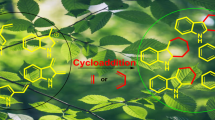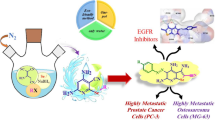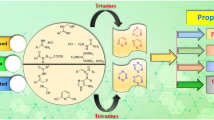Abstract
Tetraazacyclododecane and tetraazacyclotetradecane derivatives bearing a spirobenzopyran and three carboxymethyl moieties, 1 and 2, and a diethylenetriamine derivative bearing a spirobenzopyran and four carboxymethyl moieties 3 were synthesized. The isomerization behaviors based on the spirobenzopyran moiety of these ligands were studied by UV- visible spectrophotometry in aqueous solutions containing various metal ions at neutral pH. These ligands formed stable 1: 1 complexes with lanthanide ions, while the spirobenzopyran moiety was isomerized to its corresponding merocyanine form even under dark conditions. In aqueous solutions containing a lanthanide ion, the absorption spectra of 1 or 2 showed remarkable blue shifts, while absorbances at the maximum absorption wavelengths in the visible region were enhanced; such changes are attributable to the isomerization to the merocyanine form of the spirobenzopyran moiety. These results suggest that the phenolate anion of the merocyanine moiety interacts very strongly with a lanthanide ion bound by the complexing moiety because of the high charge density of lanthanide ions. In contrast, the absorbance of merocyanine form was decreased by the complexation of the macrocyclic ligand with transition metal ions, such as Cu2+ and Zn2+. This result indicates that macrocyclic ligands, 1 and 2, formed complexes with transition metal ions only by the aminocarboxylate moieties, and the phenolate ion of merocyanine moiety was not able to participate in the complexation. This conclusion was also demonstrated by density functional theory calculations.
Similar content being viewed by others
References
J. Sunamoto, K. Iwamoto, M. Akutagawa, M. Nagase, and H. Kondo, J. Am. Chem. Soc., 1982, 104, 4904.
J. Sunamoto, K. Iwamoto, Y. Mohri, and T. Kominato, J. Am. Chem. Soc., 1982, 104, 5502.
J. D. Winkler, K. Deshayes, and B. Shao, J. Am. Chem. Soc., 1989, 111, 769.
K. Kimura, S. Kanakogi, and M. Yokoyama, Anal. Sci., 1996, 12, 399.
H. Sakamoto, H. Takagaki, M. Nakamura, and K. Kimura, Anal. Chem., 2005, 77, 1999.
K. Kimura, T. Yamashita, and M. Yokoyama, J. Chem. Soc., Chem. Commun., 1991, 147.
K. Kimura, T. Yamashita, and M. Yokoyama, Chem. Lett., 1991, 965.
K. Kimura, T. Yamashita, and M. Yokoyama, J. Phys. Chem., 1992, 96, 5614.
M. Tanaka, K. Kamada, H. Ando, T. Kitagaki, Y. Shibutani, and K. Kimura, J. Org. Chem., 2000, 65, 4342.
M. Tanaka, M. Nakamura, M. A. A. Salhin, T. Ikeda, K. Kamada, H. Ando, Y. Shibutani, and K. Kimura, J. Org. Chem., 2001, 66, 1533.
K. Kimura, T. Teranishi, M. Yokoyama, S. Yajima, S. Miyake, H. Sakamoto, and M. Tanaka, J. Chem. Soc., Perkin Trans. 2, 1999, 199.
K. Kimura, H. Sakamoto, S. Kado, R. Arakawa, and M. Yokoyama, Analyst, 2000, 125, 1091.
P. Caravan, J. J. Ellison, T. J. McMurry, and R. B. Lauffer, Chem. Rev., 1999, 99, 2293.
M. P. Lowe, D. Parker, O. Reany, S. Aime, M. Botta, G. Castellano, E. Gianolio, and R. Pagliarin, J. Am. Chem. Soc., 2001, 123, 7601.
W.-H. Li, G. Parigi, M. Fragai, C. Luchinat, and T. J. Meade, Inorg. Chem., 2002, 41, 4018.
K. Hanaoka, K. Kikuchi, Y. Urano, M. Narazaki, T. Yokawa, S. Sakamoto, K. Yamaguchi, and T. Nagano, Chem. Biol., 2002, 9, 1027.
R. Delgado, J. Costa, K. P. Guerra, and L. M. P. Lima, Pure Appl. Chem., 2005, 77, 569.
C. A. Chang, L. C. Francesconi, M. F. Malley, K. Kumar, J. Z. Gougoutas, M. F. Tweedle, D. W. Lee, and L. J. Wilson, Inorg. Chem., 1993, 32, 3501.
A. Riesen, M. Zehnder, and T. A. Kaden, Acta Crystallogr., Sect. C: Cryst. Struct. Commun., 1991, 47, 531.
S. K. Kim, S. H. Lee, J. Y. Lee, R. A. Bartsch, and J. S. Kim, J. Am. Chem. Soc., 2004, 126, 16499.
Author information
Authors and Affiliations
Corresponding author
Rights and permissions
About this article
Cite this article
Machitani, K., Sakamoto, H., Nakahara, Y. et al. Molecular Design of Tetraazamacrocyclic Derivatives Bearing a Spirobenzopyran and Three Carboxymethyl Moieties and Their Metal-Ion Complexing Behavior. ANAL. SCI. 24, 463–469 (2008). https://doi.org/10.2116/analsci.24.463
Received:
Accepted:
Published:
Issue Date:
DOI: https://doi.org/10.2116/analsci.24.463




